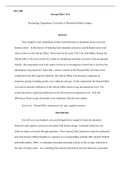Summary
Summary PSYC300 Final Paper.docx PSY-300 Stroop Effect Test Psychology Department, University of Maryland Global Campus Abstract Once taught to read, identifying written words becomes an automatic process beyond human control. In the process of studying suc
- Course
- Institution
PSYC300 Final P PSY-300 Stroop Effect Test Psychology Department, University of Maryland Global Campus Abstract Once taught to read, identifying written words becomes an automatic process beyond human control. In the process of studying such automatic processes, psychologists uncovered what i...
[Show more]



